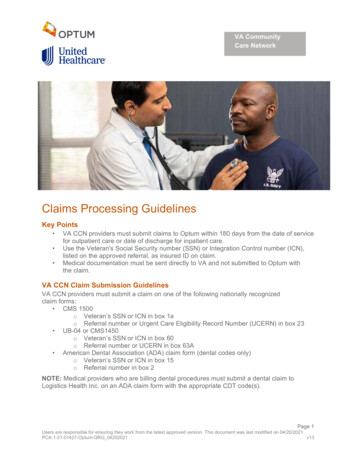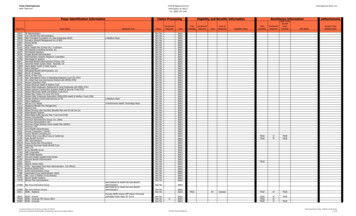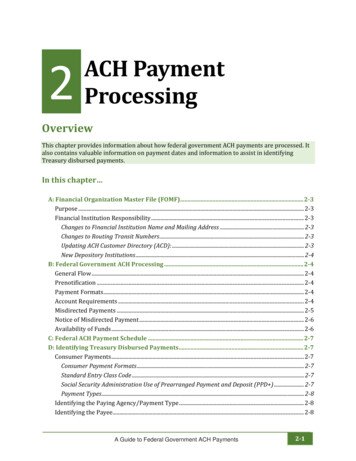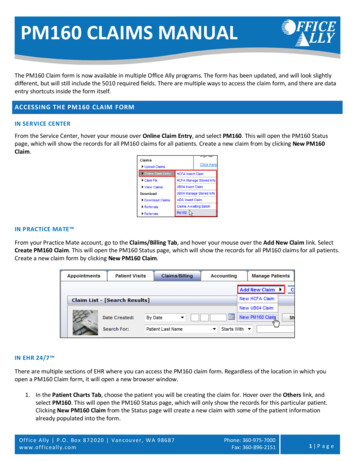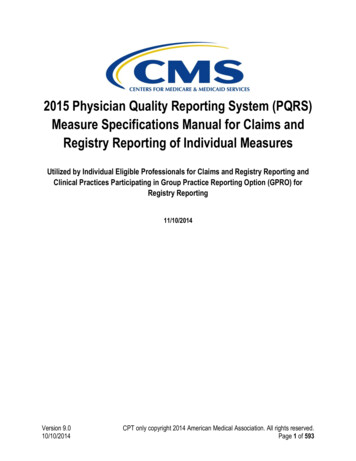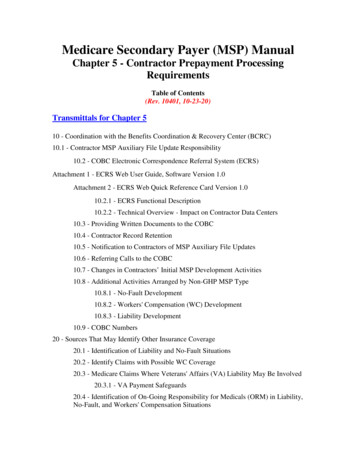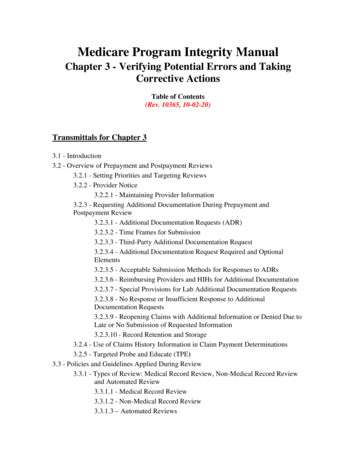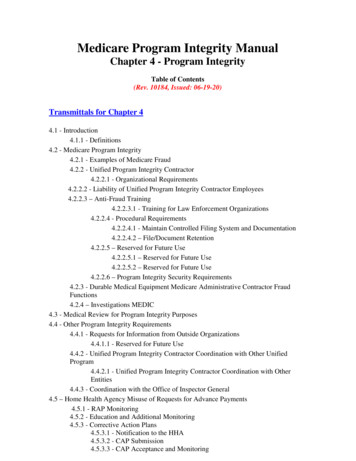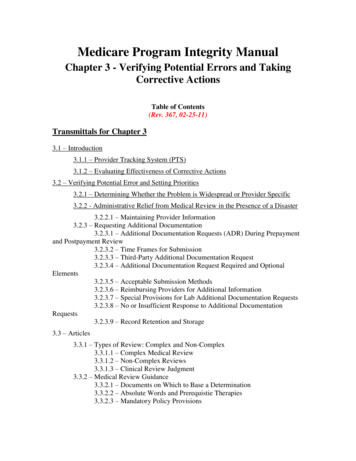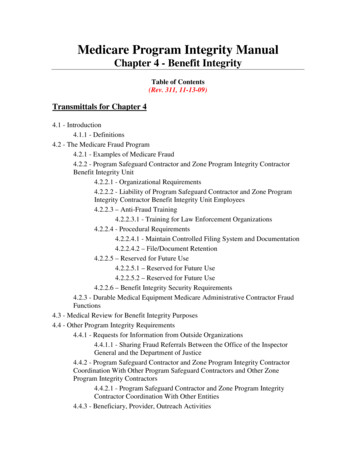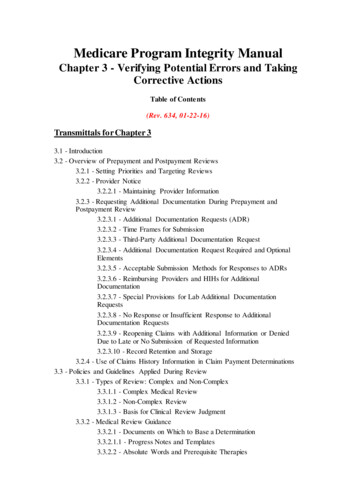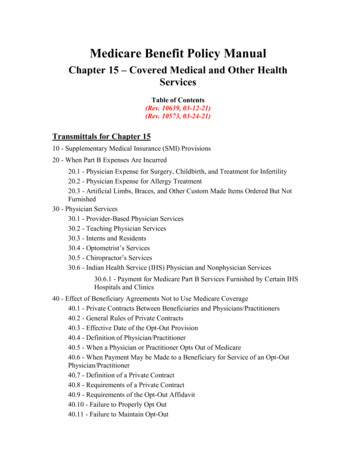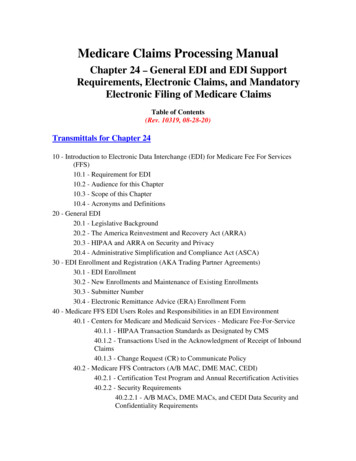
Transcription
Medicare Claims Processing ManualChapter 24 – General EDI and EDI SupportRequirements, Electronic Claims, and MandatoryElectronic Filing of Medicare ClaimsTable of Contents(Rev. 10319, 08-28-20)Transmittals for Chapter 2410 - Introduction to Electronic Data Interchange (EDI) for Medicare Fee For Services(FFS)10.1 - Requirement for EDI10.2 - Audience for this Chapter10.3 - Scope of this Chapter10.4 - Acronyms and Definitions20 - General EDI20.1 - Legislative Background20.2 - The America Reinvestment and Recovery Act (ARRA)20.3 - HIPAA and ARRA on Security and Privacy20.4 - Administrative Simplification and Compliance Act (ASCA)30 - EDI Enrollment and Registration (AKA Trading Partner Agreements)30.1 - EDI Enrollment30.2 - New Enrollments and Maintenance of Existing Enrollments30.3 - Submitter Number30.4 - Electronic Remittance Advice (ERA) Enrollment Form40 - Medicare FFS EDI Users Roles and Responsibilities in an EDI Environment40.1 - Centers for Medicare and Medicaid Services - Medicare Fee-For-Service40.1.1 - HIPAA Transaction Standards as Designated by CMS40.1.2 - Transactions Used in the Acknowledgment of Receipt of InboundClaims40.1.3 - Change Request (CR) to Communicate Policy40.2 - Medicare FFS Contractors (A/B MAC, DME MAC, CEDI)40.2.1 - Certification Test Program and Annual Recertification Activities40.2.2 - Security Requirements40.2.2.1 - A/B MACs, DME MACs, and CEDI Data Security andConfidentiality Requirements
40.2.2.2 - A/B MAC, DME MACs and CEDI Audit Trails40.2.2.3 - Security-Related Requirements for A/B MACs, andCEDI Arrangements With Clearinghouses and Billing Services40.2.2.4 - Release of Medicare Data40.2.2.5 - EDI Enrollment and EDI Claim Record Retention40.2.3 - General EDI Outreach Activities40.2.3.1 - A/B MAC and DME MAC Analysis of InternalInformation40.2.3.2 - Contact With New Providers40.2.3.3 - Production and Distribution of Information to IncreaseUse of EDI40.2.3.4 - Production and Distribution of Material to Market EDI40.2.4 - Trading Partner Management40.2.4.1 - User Guidelines40.2.4.2 - Technical Assistance to EDI Trading Partners40.2.4.3 - Training Content and Frequency40.2.4.4 - Prohibition Against Requiring Use of ProprietarySoftware or DDE40.2.4.5 - Free Claim Submission Software40.2.4.6 - Newsletters/Bulletin Board/Internet Publication of EDIInformation40.2.4.7 - Provider Guidelines for Choosing a Vendor40.2.4.7.1 - Determining Goals/Requirements40.2.4.7.2 - Vendor Selection40.2.4.7.3 - Evaluating Proposals40.2.4.7.4 - Negotiating With Vendors40.2.5 - Provision of EDI User Guidelines40.2.6 - Provision and Maintenance of a Directory of Billing SoftwareVendors and Clearinghouses40.2.7 - Operating Rules for Electronic Transactions40.3 - Trading Partners50 - Technical Requirements50.1 - Telecommunications, Internet and Dial-up50.1.1 - System Availability50.1.2 - Media50.1.3 - Telecommunications and Transmission Protocols50.1.4 - Toll-Free Service50.2 - Translators50.3 - Common Edits and Enhancements Module (CEM) - General DescriptionAcross All Versions
50.3.1 - Claim Numbering50.3.2 - Receipt Control and Balancing50.3.3 - Acknowledgements50.3.3.1 - Outbound File Compliance Check50.3.4 - Common Edits and Enhancement Module (CEM) Code SetsRequirements50.3.5 - Handling of Poorly Formed/Invalid Flat Files for a 277CA50.4 - CEDI - Unique Specifications for DME50.4.1 - CEDI Claim Numbering50.4.2 - CEDI Receipt Control and Balancing50.4.3 - CEDI Acknowledgments for ASC X12 and NCPDP D.O.Transactions50.5 - EDI Testing Accuracy50.5.1 - Limitation on Testing of Multiple Providers that Use the SameClearinghouse, Billing Service, or Vendor Software50.5.2 - EDI Receiver Testing by A/B MACs and CEDI50.6 - Changes in Provider’s System or Vendor’s Software and Use of AdditionalEDI Formats50.7 - Delimiters50.8 - Nulls50.9 - Direct Data Entry (DDE) Screens50.10 - Additional Documentation Submitted Via Paperwork (PWK) Segment50.10.1 - PWK Background50.10.2 - PWK Workflow50.10.2.1 - Provider Responsibility50.10.2.2 - Contractor Responsibility60 - EDI Edit Requirements60.1 - A/B MACs, and CEDI Edit Requirements60.2 - Key Shop and Optical Character Recognition60.2.1 - Claim Key Shop and Optical Character Recognition (OCR)/ImageCharacter Recognition (ICR) Mapping to ASC X12 Based Flat File60.2.2 - Key Shop and Image Processing60.3 - COB Trading Partner and Contractor Crossover Claim Requirements60.4 - Remittance Advice and Standard Paper Remittances60.5 - Payments60.5.1 - Payment Floor Requirement60.5.2 - Alternative to EFT60.5.3 - Electronic Funds Transfer (EFT)60.5.4 - Tri-Partite Bank Agreement
60.6 - Health Care Provider Taxonomy Code (HPTC) Requirements70 - CMS Defined File Formats70.1 - General HIPAA EDI Requirements70.2 - National Council for Prescription Drug Program (NCPDP) ClaimRequirements80 - Electronic Data Interchange (EDI) Reporting Requirements80.1 - Contractor Monthly Status Reporting80.2 - Common Edits and Enhancement Module (CEM) Reporting80.3 - Common Electronic Data Interchange (CEDI) Reporting80.4 - HIPAA Transition Reporting80.5 - Administrative Simplification and Compliance Act (ASCA) Reporting90 - Mandatory Electronic Submission of Medicare Claims90.1 - Small Providers and Full-Time Equivalent Employee Self-Assessments90.2 - Exceptions90.3 - “Unusual Circumstance” Waivers90.3.1 - Unusual Circumstance Waivers Subject to Provider SelfAssessment90.3.2 - Unusual Circumstances Waivers Subject to a ContractorEvaluation for CMS Decision90.4 - Electronic and Paper Claims Implications of Mandatory ElectronicSubmission90.5 - Enforcement90.5.1 - FISS Role in ASCA Enforcement90.5.2 - MCS & VMS Roles in ASCA Enforcement90.5.3 - Contractor Roles in ASCA Reviews90.5.4 - Submission of Claims that May Always be Submitted on Paper byProviders Not Otherwise Eligible to Submit Paper Claims90.6 - Provider Education90.7 - Application of Electronic Data Interchange Enrollment Information andASCA Enforcement Review Decisions from Other Medicare Contractors to theSame Providers When They Bill the Railroad Retirement Board Specialty MAC(SMAC)90.7.1 - RMC Entry of ASCA Enforcement Review Decisions and EDIEnrollment Information from Other Medicare Contractors into PES90.7.2 - Selection of Providers to be Sent Initial Letters for the RMC toBegin an ASCA Enforcement Review90.7.3 - Subsequent Reversal of Decision that a Provider is Not Eligible toSubmit Paper Claims by a Non-RR Medicare Contractor90.7.4 - Number of ASCA Enforcement Reviews to be Conducted by theRMC
90.7.5 - RMC Information in ASCA Enforcement Review Letters90.7.6 - RMC Costs Related to Use of ASCA Review Information inSuperPES FilesExhibits of Form LettersExhibit A - Response to a non- “unusual circumstance” waiver requestExhibit B - Denial of an “unusual circumstance” waiver requestExhibit C - Request for Documentation from Provider Selected for Review toEstablish Entitlement to Submit Claims on PaperExhibit D - Notice that paper claims will be denied effective with the 91st calendarday after the original letter as result of non-response to that letterExhibit E - Notice that paper claims will be denied effective with the 91st calendarday after the original letter as result of determination that the provider is noteligible to submit paper claims.Exhibit F - Notice that determination reached that the provider is eligible tosubmit paper claims.Exhibit G - Notice from the Railroad Retirement Board Specialty MAC to aProvider that Has Just Begun to Submit Claims that Paper Claims Submitted bythat Provider Will be DeniedExhibit H - Notice from the Railroad Retirement Board Specialty MAC to aProvider with a Pre-Established Record in PES that Paper Claims Will Be Deniedas Result of the Requirement that a Provider Submit Claims to One or More OtherMedicare Contractors Electronically
10 - Introduction to Electronic Data Interchange (EDI) for MedicareFee For Services (FFS)(Rev. 2803, Issued: 10-28-13, Effective: 09-17-13, Implementation: 09-17-13)EDI for Medicare FFS is not limited to the submission and processing of claim relatedtransactions, but includes processes such as provider EDI enrollment, beneficiaryeligibility, coordination of benefits, as well as security and privacy concerns. So as not tobe duplicative, where EDI is a relevant part of a Medicare business process, it will beindicated here, however, the specifics of the business process will be maintained in itsrespective IOM chapter or comparable communication venue.10.1 - Requirement for EDI(Rev. 2803, Issued: 10-28-13, Effective: 09-17-13, Implementation: 09-17-13)For a provider, business associate, or other trading partner to engage in EDI withMedicare FFS, it must first establish an EDI agreement with Medicare. There are twoways to do this: 1) complete and submit paper CMS Form 855, or 2) submit an Internetbased application via the Provider Enrollment, Chain and Ownership System (PECOS)system. More information on enrolling in the Medicare Program can be found tml?redirect /medicareprovidersupenroll10.2 - Audience for this Chapter(Rev. 2803, Issued: 10-28-13, Effective: 09-17-13, Implementation: 09-17-13)The information contained in this chapter will be of interest to Medicare providers,business associates or other trading partners, as well as others interested in how Medicarehas structured its EDI policies. Other Medicare FFS and CMS partners as well as generalaudiences may use this as a source of information to determine Medicare FFS’ EDIpractices. Primarily however, this chapter, and related chapters, are used by Medicarecontractors for descriptive guidance to contractual responsibilities they have to CMS.Therefore, the instructions within this chapter are primarily directed to MedicareAdministrative Contractors (MACs), Durable Medical Equipment MedicareAdministrative Contractors (DME MACs), the Common Electronic Data Interchange(CEDI) contractor for DME MACs, and their shared systems, and are in reference toMedicare requirements for their implementation of the current HIPAA compliant versionof the Accredited Standards Committee (ASC) X12 Technical Report Type 3 (TR3) alsoknown as an ASC X12 Implementation Guide (IG) and NCPDP TelecommunicationImplementation Guide, as well as all Medicare and contractor EDI activities related tothese transactions. In order to implement the HIPAA administrative simplificationprovisions, specific ASC X12 and NCPDP transactions have been named under part 162of title 45 of the Code of Federal Regulations as electronic data interchange (EDI)standards for Health Care. All other EDI formats for health care became obsolete onOctober 16, 2003. The Final Rule for Health Insurance Reform: Modifications to the
Health Insurance Portability and Accountability Act (HIPAA) Electronic TransactionStandards published in the act, adopted updated versions of HIPAA mandated electronic transactions.Furthermore, the Final Rule conveys inclusion of errata documents to the transactionstandard(s). Medicare FFS therefore incorporates by reference any errata documents bythe original mandated regulation compliance date through the Federal Register notice(s).Moving forward, all newly adopted errata documents are to be accepted and integrated aspart of the EDI transaction(s). Medicare FFS further adopts the Accredited StandardsCommittee (ASC) X12 and National Council for Prescription Drug Programs (NCPDP)transaction standards as part of its EDI Acknowledgment Model.10.3 - Scope of this Chapter(Rev. 2803, Issued: 10-28-13, Effective: 09-17-13, Implementation: 09-17-13)This chapter will provide an overall description of EDI operations, requirements, rolesand responsibilities for Medicare FFS.Medicare FFS is utilizing the following EDI transactions:Transactions (Required Under HIPAAUnless Otherwise Noted)ASC X12 Health Care Eligibility BenefitInquiry and Response (270/271)ASC X12 Health Care Claim:Professional (837)ASC X12 Health Care Claim:Institutional (837)ASC X12 Interchange Acknowledgment,TA1(not required under HIPAA)ASC X12-ImplementationAcknowledgment For Health CareInsurance (999) (not required underHIPAA)ASC X12 Health Care ClaimPayment/Advice (835)ASC X12 Health Care ClaimStatus Request and Response (276/277)CurrentShort ReferenceVersion005010X279A1 ASC X12 270/271eligibility transaction005010X222A1 ASC X12 837professional claim005010X223A2 ASC X12 837institutional claim005010X231A1 ASC X12 TA1interchangeacknowledgment005010X231A1 ASC X12 999implementationacknowledgment005010X221A1 ASC X12 835 remittanceadvice005010X212ASC X12 276/277 claimstatus; ASC X12 276/277claim status request andresponse; ASC X12 276claim status request; ASCX12 277 claim statusresponse
Transactions (Required Under HIPAAUnless Otherwise Noted)ASC X12 Health Care ClaimAcknowledgment (277) (not requiredunder HIPAA)Telecommunication Standard,National Council for Prescription DrugProgramsCurrentVersion005010X214Batch Standard, National Council forPrescription Drug Programs1.2D.0Short ReferenceASC X12 277CA claimacknowledgmentDepending upon context:NCPDP claim; NCPDPtransaction; otherfunctional NCPDPdesignationDepending upon context:NCPDP claim; NCPDPbatch transaction; NCPDPtransaction; otherfunctional NCPDPdesignationThese administrative transactions require detailed instructions and specifications.General instructions for the institutional and professional claim transactions, the NCPDPtransaction, as well as the error handling/acknowledgment transactions are providedwithin this chapter. All other transactions have separate chapters dedicated to them.The following IOM Publication 100-04, chapters provide more specific information onthe remaining electronic transactions. References to these chapters are provided below.They can be accessed by going ance/Manuals/Internet-OnlyManuals-IOMs.html and selecting Publication # 100-04.1. Chapter 22 - ASC X12 835 remittance advice (includes information for paperremittance advices)2. Chapter 31 -ASC X12 270/271 eligibility benefit inquiry and response and ASC X12276/277 claim status request and responseTwo other related IOM chapters include:Chapter 25 -Completing and Processing the Form CMS-1450 Data Set (includesinformation related to ASC X12 837 institutional claims)Chapter 26 -Completing and Processing the Form CMS-1500 Data Set (related to ASCX12 837 professional claims)Other sources of detailed information for each of these transactions are the Medicare FFSCompanion Guide documents and Medicare FFS edits documentation which can befound at http://www.cms.gov/ElectronicBillingEDITrans/.
10.4 - Acronyms and Definitions(Rev. 3346, Issued: 09-04-15, Effective: 10-06-15, Implementation: 10-06-15)The following is a list of terms and acronyms if assistance is needed to understand theterminology used in this chapter. EDI – Electronic Data Interchange - the process of using nationally establishedstandards to exchange electronic information between business entities. HIPAA – Health Insurance Portability and Accountability Act of 1996 –legislation that mandated that the healthcare industry use standard formats forelectronic claims and claims related transactions. MAC – Medicare Administrative Contractor – Section 911 of the MedicareModernization Act of 2003 mandated that the Secretary for Health & HumanServices replaced the contractors administering the Medicare Part A or Part B feefor-service programs with Medicare Administrative Contractors (MACs). PartA/Part B Medicare Administrative Contractors (MACs) replaced the fiscalintermediaries and carriers and handle administration of both the Medicare Part Aand Part B programs in specified geographic regions. For more information,please see the CMS overview of Medicare Contracting Reform. A/B MAC – Medicare Administrative Contractor servicing both Part A and Part Blines of business. DME MAC – Durable Medical Equipment Medicare Administrative Contractor CEDI - Common Electronic Data Interchange – Common front end for DMEMACs Trading Partner – one of two or more participants in an ongoing businessrelationship (e.g., provider, billing service, software vendor, employer group,financial institution, etc.). Submitter – an entity that owns the healthcare data being submitted. It is mostlikely the provider, hospital, clinic, etc. A submitter is directly linked to eachbilling NPI. EDI Enrollment – establishes documentation specifying type of transactions andtransmission methods to be used in the exchange of electronic administrativetransactions. EDI Registration – designates the Medicare contractor as the entity they agree toengage with for EDI and ensures agreement between parties to implementstandard policies and practices to ensure the security and integrity of informationexchanged.
Trading Partner Agreement – ensure the integrity of the electronic transactionprocess. The Trading Partner Agreement is related to the electronic exchange ofinformation, whether the agreement is an entity or a part of a larger agreement,between each party to the agreement. Third Party Agreement- ensures the confidentiality, security, and integrity ofMedicare data being shared by third party agents that represent providers, certainvalue-added networks, clearinghouses, and billing agents.20 - General EDI(Rev. 2803, Issued: 10-28-13, Effective: 09-17-13, Implementation: 09-17-13)EDI is the process of using nationally established standards to exchange electronicinformation between business entities. These national standards are developed andmaintained by a group of standards development organizations (SDOs), such as theAccredited Standards Committee (ASC) X12 and the National Council of PrescriptionDrug Programs (NCPDP). The Department of Health and Human Services (HHS)adopted certain electronic standards for use in health care under the Health InsurancePortability and Accountability Act of 1996 (HIPAA). Medicare FFS is required, as areall payers in the US, to adopt the standards specified under HIPAA. However, as part ofMedicare FFS’ EDI Acknowledgement Model, three additional ASC X12 standards willbe adopted for error handling (277CA claim acknowledgment, 999 implementationacknowledgment, and TA1 interchange acknowledgment) that are not mandated underHIPAA. In addition, there will be one additional standard adopted for NCPDP errorhandling (transmission response) that is not mandated under HIPAA.20.1 - Legislative Background(Rev. 2803, Issued: 10-28-13, Effective: 09-17-13, Implementation: 09-17-13)EDI practices for healthcare business were embraced more than 20 years ago tostandardize electronic formats throughout the healthcare industry. Usage of EDI inHealth care claim processing was initiated by the Health Insurance Portability andAccountability Act of 1996(HIPAA), Public Law 104,191. Subtitle F of Title II ofHIPAA, added to Title XI of the Social Security Act (the Act) a new part called sectionC, entitled “Administrative Simplification” and consists of sections 1171 through 1180.This Federal legislation adopted standards for electronic transactions under anAdministrative Simplification subtitle. HIPAA mandated the adoption of standards forelectronically transmitting certain health care administrative transactions between allcovered entities.Sections 1171 through 1179 are described below: Section 1171 of the Act, established definitions for the following: code sets, healthcare clearinghouses, health care provider, health information, health plan,
individually identifiable health information, standard, and standard settingorganizations (SSO) such as the American National Standards Institute (ANSI). Section 1172 made any standard adopted applicable to covered entities that transmithealth information in electronic for
General EDI and EDI Support Requirements, Electronic Claims, and Mandatory Electronic Filing of Medicare Claims. Table of Contents (Rev. 10319, 08-28-20) Transmittals for Chapter 24. 10 - Introduction to Electronic Data Interchange (EDI) for Medicare Fee For Services (FFS) 10.1 - Requirement
